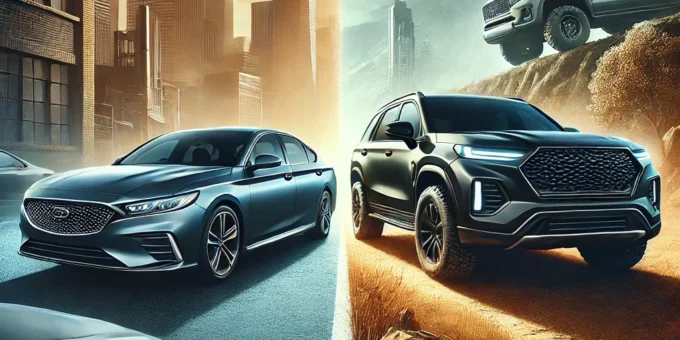
Choosing the right vehicle can be a tough decision, especially when deciding between a sedan and an SUV. Both vehicle types have their advantages and drawbacks, depending on your needs, lifestyle, and budget. Sedans are known for their efficiency and affordability, while SUVs excel in versatility and space.
In this comprehensive guide, we’ll explore the pros and cons of sedans and SUVs, helping you make an informed decision that aligns with your priorities.
Introduction
The decision between a sedan and an SUV is one of the most common dilemmas faced by car buyers. While sedans offer comfort and efficiency, SUVs provide practicality and the ability to handle diverse terrains. By understanding the key differences, you can determine which option is the better fit for your lifestyle.
Why the Choice Matters
- Budget: Sedans typically cost less upfront, while SUVs may have higher initial and maintenance costs.
- Lifestyle: Your family size, driving habits, and travel needs play a big role in determining the right vehicle.
- Utility: Consider factors like cargo space, towing capacity, and off-road capabilities.
Pros and Cons of Sedans
Pros of Sedans
- Fuel Efficiency
- Sedans are lighter and more aerodynamic, offering superior fuel economy compared to most SUVs.
- Ideal for daily commutes and long highway drives.
- Affordability
- Lower purchase price and insurance premiums compared to SUVs.
- Reduced maintenance costs due to simpler mechanics.
- Ease of Handling
- Smaller size makes sedans easier to park and maneuver in tight spaces.
- Provides a smoother ride, especially on paved roads.
- Stylish Design
- Sleek, low-profile designs appeal to those who value aesthetics.
Example: Toyota Camry, Honda Accord, and Tesla Model 3 are popular sedan choices.
Cons of Sedans
- Limited Space
- Smaller cabins and trunks may not accommodate larger families or bulky items.
- Lower Ground Clearance
- Sedans are less suited for off-road adventures or rough terrains.
- Less Versatility
- May struggle to meet the needs of families or those with outdoor hobbies.
Pros and Cons of SUVs
Pros of SUVs
- Spacious Interiors
- SUVs offer ample headroom, legroom, and cargo space, making them ideal for families.
- Folding rear seats add flexibility for transporting larger items.
- High Ground Clearance
- Allows for better visibility and capability on rough or uneven roads.
- Suitable for off-road driving and harsh weather conditions.
- Towing Capacity
- Many SUVs can tow boats, trailers, or campers, making them perfect for outdoor enthusiasts.
- All-Wheel Drive Options
- Enhanced traction and stability for driving on snow, mud, or gravel.
Example: Honda CR-V, Toyota RAV4, and Ford Explorer are popular SUV options.
Cons of SUVs
- Higher Costs
- SUVs generally cost more to buy, insure, and maintain than sedans.
- Fuel economy is lower, leading to higher running costs.
- Bulkier Design
- Larger size makes SUVs harder to park and maneuver in urban areas.
- Rougher Ride Quality
- Stiffer suspensions can result in a less comfortable ride compared to sedans.
How to Decide Between a Sedan and an SUV
1. Assess Your Needs
- Family Size: Larger families or those with children may benefit from the extra space in an SUV.
- Cargo Requirements: If you frequently transport equipment or luggage, an SUV’s versatility is a clear advantage.
- Commute and Travel Habits: Sedans are great for city driving, while SUVs excel on long trips or rough terrains.
2. Consider Your Budget
- Upfront Costs: Sedans are generally more affordable.
- Long-Term Costs: Factor in fuel, insurance, and maintenance expenses.
- Resale Value: SUVs often retain their value better than sedans due to higher demand.
3. Evaluate Driving Conditions
- Urban Environments: Sedans are easier to park and handle in crowded cities.
- Rural or Off-Road Areas: SUVs offer better performance on unpaved roads.
- Weather: If you live in snowy or rainy regions, an SUV with AWD is a safer option.
4. Test Drive Both Options
Experience the driving dynamics of both sedans and SUVs to see which feels more comfortable:
- Sedans: Notice the smoothness and ease of handling.
- SUVs: Evaluate the visibility, seating position, and space.